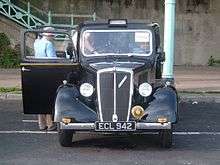Nuffield Oxford Taxi
The Nuffield Oxford Taxi, initially produced as the Wolseley Oxford Taxicab was the first new taxicab designed to comply with the Metropolitan Police Conditions of Fitness for London taxicabs to be launched on the British market after the end of the Second World War.
| Nuffield Oxford Taxi | |
|---|---|
 Nuffield Oxford Series I | |
| Overview | |
| Manufacturer | Nuffield |
| Also called | Wolseley Oxford |
| Model years | 1947–1953 |
| Assembly | Ward End Birmingham, later Adderley Park, Birmingham |
| Designer | Chassis: Charles van Eugen |
| Body and chassis | |
| Body style | London taxi, fixed head |
| Layout | Limousine |
| Powertrain | |
| Engine | Nuffield 1802cc 4-cylinder ohv petrol, dry sump |
| Transmission | Nuffield 4-speed manual |
| Dimensions | |
| Wheelbase | 8ft 11 1/2in |
| Length | 13ft 11 1/2in |
| Width | 5ft 6in |
| Chronology | |
| Predecessor | Morris-Commercial G2SW |
Royal wedding
The Oxford was introduced at the Commercial Motor Exhibition of 1947, and a fleet of new cabs served to carry guests from the wedding of Princess Elizabeth and Philip Mountbatten (now Queen Elizabeth II and the Duke of Edinburgh) at Westminster Abbey in November of that year.
Design
The prototype, designed by Morris-Commercial, registration number EOM 844 was built in 1940 and was fitted with a landaulette body by Jones Brothers of Westbourne Grove, London. It accumulated a recorded 300,000 miles (480,000 km) in tests throughout the Second World War.[1]
New regulations
Changes in the Conditions of Fitness after the Second World War banned the landaulette style of body and the production vehicle was fitted with a fixed head body, of pressed steel over a wood frame. With its limousine configuration and open luggage platform beside the driver, it was in every other respect the same style as all previous London taxis. It was the last new design to be launched at the historic Ward End, Birmingham, plant which had been Wolseley's home since 1919.[2]
Specification
It was powered by an 1802 cc petrol inline-four engine with a dry sump, based on an industrial version of an engine used in pre-war Morris and MG cars. The gearbox had four speeds with synchromesh on second, third and top. The brakes were mechanically operated by rods and the back axle was worm gear driven. A four-door hire car version was also made.
Manufacture and distribution

Production was transferred to Nuffield's Adderley Park factory in 1948, and continued until 1953. The previous year, Nuffield had merged with Austin to form the British Motor Corporation, and the new management, headed by Leonard Lord axed the Oxford in favour of the Austin FX3, which had been launched in 1948.[3] Beardmore Motors would go on to produce a cab of their own once more.
Manufactured
A total of 1,926 [4] of all models were made.
| Ward End | Adderley Park | |||
|---|---|---|---|---|
Distribution, sales and servicing were carried out by Beardmore Motors of Hendon. Beardmore, once a part of William Beardmore and Company had been taxi makers since 1919, but had ceased production of their last model before the outbreak of war.
Revisions
Three models were produced, each a detail improvement of the previous. The Series I of 1947 had artillery wheels. The Series II, introduced in 1949 had pressed steel wheels and the Series III of 1950 had what was, in effect a six light[5] body, although of course the luggage platform had no door and thus no window.
Wolseley
Note: The Oxford is known by many as a Wolseley model, as it was designed and first built at the Wolseley factory at Ward End. The manufacturer's name as recognised by the DVLA, and shown on some Road Fund Licence ('tax') discs and V5 registration documents is Nuffield. However, it should be understood that the DVLA is not authoritative on manufacturer names. The 1948 instruction manual for the Oxford Taxicab makes it clear that this was a Wolseley model,[6] as does the manufacturer's plate under the bonnet.
Notes and references
- 2006 interview with Roy Perkins, driver of the prototype Oxford
- "History of the Ward End works". Austin-rover.co.uk. Archived from the original on 8 October 2007. Retrieved 22 April 2012.
- Adams, Keith. "Austin FL2/FX4". www.aronline.co.uk. Retrieved 19 April 2016.
- Society of Motor Manufacturers and Traders figures
- A six light body is one with three windows on each side, usually one in each door and an extra one on the rear quarter
- Instruction Manual for the Oxford Taxicab, Wolseley Motors Ltd
Further reading
- G.N. Georgano, "A History of the London Taxicab" David & Charles 1971 0-7153-5687-0 (out of print)
- G.N. Georgano & Bill Munro, The London Taxi Shire Publications 2008 ISBN 978-0-7478-0692-9
- Bill Munro, London Taxis – a Full History Earlswood Press 2011 ISBN 978-0-9562308-2-9